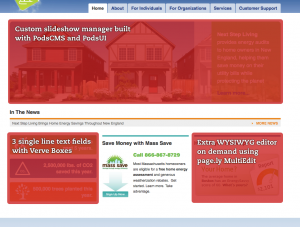 The WordPress WYSIWYG/TinyMCE editor is great but can’t fulfill the needs of a robust CMS. When creating a CMS with WordPress you often find yourself needing to manage detailed areas and modules, and the current custom field editor doesn’t cut it in terms of usability for clients. Using the following plugins you can allow your clients to manage content using:
The WordPress WYSIWYG/TinyMCE editor is great but can’t fulfill the needs of a robust CMS. When creating a CMS with WordPress you often find yourself needing to manage detailed areas and modules, and the current custom field editor doesn’t cut it in terms of usability for clients. Using the following plugins you can allow your clients to manage content using:
- Single line text
- Paragraph textarea
- Inline image uploader
- File attachments
- Date picker
- Dropdown/select fields
- Yes/no/multiple choice with radios or checkbooks
- Managing slideshows
- Using more than one rich content area (WYSIWYG)
I’ve written posts about this in the past, but things in the WordPress world move fast. Below is my new evolved toolbox of go-to plugins I recommend using for your customized WordPress CMS setup.
1. PodsCMS & PodsUI
Sometimes you need to create a custom post type separate from Pages and Posts. Pods allows you to do this with ease, providing you with an interface to create new columns in your database. A dealer locator, a homepage slideshow or a customized video manager are all great possibilities to be built with Pods. Once you have your Pods setup, you can cleanup and customize the administrative view in WordPress using PodsUI. This allows you to add advanced pagination, custom sortable column headers and even a drag and drop re-order interface. If your interested in Pods I would suggest jumping over to Jonathan Christopher’s website Monday by Noon.
2. Verve Boxes
Verve Boxes is a tool allowing you to basically customize the WordPress Custom Fields interface. Use Verve Boxes to quickly and easily attach custom meta boxes to Pages or Posts using a slick drag and drop AJAX interface. In your meta boxes you can add all sorts of form fields including select dropdown’s, radio’s, checkboxes, single line text boxes, file & image uploaders and even a date picker. It’s currently missing is the ability to add boxes on a page by page basis, but it can be done with some JS/CSS/PHP to detect what page is being viewed, and hide the meta box if it’s not needed. If anyone’s interested in how to do this let me know I’d be happy to show you.
3. page.ly Multiedit
With custom post types being introduced to the WordPress 3.0 core custom post type plugins like More Fields and Flutter are essentially dead. I’ve been using a little plugin called page.ly Multiedit to add more than one WYSIWYG area to a page. One feature I LOVE about Multiedit is that it allows me to add extra editable regions on demand as needed using custom templates. If my custom templates references a multiedit area, it shows up in the WordPress admin. If a custom template isn’t used or a specific area isn’t referenced, the extra areas don’t show up. The extra WYSIWYG editors also display in a slick tabbed interface in WordPress, making it very easy for editors to use.
4. Supple Forms
As an alternative to Verve boxes, Supple forms seems to have a little more solidity under it’s feet with more downloads and a longer development life. I choose Verve boxes over Supple Forms because Verve has an inline image uploader that I use quite often. Other than that I believe the two are essentially identical aside from their interface.
5. Fitr Theme Options
Have you ever wanted to create a theme options page? It can be time consuming and difficult for less experienced PHP developers. Fitr Theme Options takes care of the heavy lifting, and allows you to quickly and easily add a custom options page to your theme. Recently I’ve been using this to provide people with a place to make changes site-wide to elements such as footer text and copyrights, headline teasers and sidebar content.
6. CMS Page Tree View
Developed by Par Thernstrom of Mars April in Stockholm, this impressive replacement for the WordPress Pages view provides you with an expanding and collpasing page tree interface within WordPress. Beyond that you can drag and drop re-order your pages, quickly moving pages around in your site (even across various sections). I used to use My Page Order for this, but CMS Page Tree is far superior in my opinion. I’m currently using this on all my CMS projects and I haven’t had any issues. Thanks for the email about this Par, keep up the great work!
Something missing?
Let me know if there’s a plugin or method you frequently use in your WordPress CMS setups. I’m sure there are many other plugins and techniques out there that I’ve missed.
